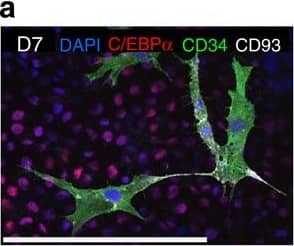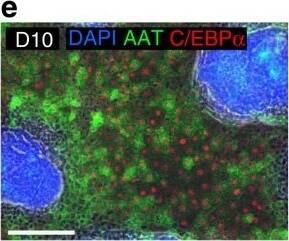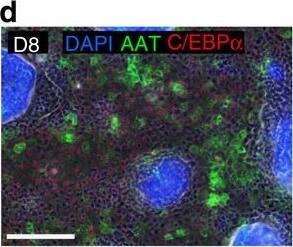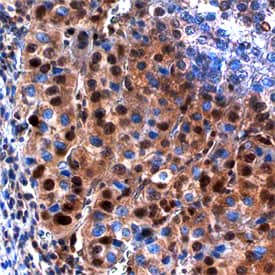Human CEBP alpha Antibody
R&D Systems, part of Bio-Techne | Catalog # AF7094

Key Product Details
Species Reactivity
Applications
Label
Antibody Source
Product Specifications
Immunogen
Met1-Ala124
Accession # P49715
Specificity
Clonality
Host
Isotype
Scientific Data Images for Human CEBP alpha Antibody
CEBP alpha in Human Liver.
CEBP a was detected in immersion fixed paraffin-embedded sections of human liver using Sheep Anti-Human CEBP a Antigen Affinity-purified Polyclonal Antibody (Catalog # AF7094) at 5 µg/mL overnight at 4 °C. Tissue was stained using the Anti-Sheep HRP-DAB Cell & Tissue Staining Kit (brown; Catalog # CTS019) and counterstained with hematoxylin (blue). Specific staining was localized to nuclei in hepatocytes. View our protocol for Chromogenic IHC Staining of Paraffin-embedded Tissue Sections.Detection of Human CEBP alpha by Immunocytochemistry/Immunofluorescence
Development of endothelial and mesenchymal like cells and maturation of hepatic endoderm.(a) CD34 and CD93 were detected in endothelial progenitor-like cells on day 7. CEBP alpha+marks the hepatic endoderm in the background (scale bars, 200 μm). (b) Development of endothelial-like cells (arrows indicate CD31). CD34 is present in the hepatocyte-like cell fraction (CEBP alpha+, CD146−) and in the endothelial-like cells (CEBP alpha−, CD146+). (c) CD51+, NES+, PDGFR alpha+ mesenchymal stem cell-like cells develop in conjunction with hepatoblasts. (d) AAT and CEBP alpha on day 8 and (e) 10 show maturation of hepatic endoderm. (f) Upregulation of AAT and fibrinogen (Fib) synthesis (ELISA). Data are mean±s.e.m., n=3 per group. Scale bars: 200 μm. Image collected and cropped by CiteAb from the following publication (https://pubmed.ncbi.nlm.nih.gov/26732624), licensed under a CC-BY license. Not internally tested by R&D Systems.Detection of Human CEBP alpha by Immunocytochemistry/Immunofluorescence
Development of endothelial and mesenchymal like cells and maturation of hepatic endoderm.(a) CD34 and CD93 were detected in endothelial progenitor-like cells on day 7. CEBP alpha+marks the hepatic endoderm in the background (scale bars, 200 μm). (b) Development of endothelial-like cells (arrows indicate CD31). CD34 is present in the hepatocyte-like cell fraction (CEBP alpha+, CD146−) and in the endothelial-like cells (CEBP alpha−, CD146+). (c) CD51+, NES+, PDGFR alpha+ mesenchymal stem cell-like cells develop in conjunction with hepatoblasts. (d) AAT and CEBP alpha on day 8 and (e) 10 show maturation of hepatic endoderm. (f) Upregulation of AAT and fibrinogen (Fib) synthesis (ELISA). Data are mean±s.e.m., n=3 per group. Scale bars: 200 μm. Image collected and cropped by CiteAb from the following publication (https://pubmed.ncbi.nlm.nih.gov/26732624), licensed under a CC-BY license. Not internally tested by R&D Systems.Applications for Human CEBP alpha Antibody
Immunohistochemistry
Sample: Immersion fixed paraffin-embedded sections of human liver
Formulation, Preparation, and Storage
Purification
Reconstitution
Formulation
Shipping
Stability & Storage
- 12 months from date of receipt, -20 to -70 °C as supplied.
- 1 month, 2 to 8 °C under sterile conditions after reconstitution.
- 6 months, -20 to -70 °C under sterile conditions after reconstitution.
Background: CEBP alpha
CEBP alpha (CCAAT/Enhancer-Binding Protein; also C/EBP) is a 42-43 kDa member of the C/EBP subfamily, bZIP family of proteins. It is expressed in multiple cell types, particularly those that are fully differentiated, and includes hepatocytes, skeletal muscle cells, adipocytes, intestinal epithelium and proliferating macrophages. CEBP alpha acts as a transcriptional activator for a large and diverse number of genes, including glycogen synthase, GLUT4, and G-CSFR, and participates in both cell cycle progression and differentiation. Human CEBP alpha is 358 amino acids (aa) in length). It contains one transactivation domain (aa 1-96), poly-Gly segment (aa 99-104), a poly-Pro motif (aa 183-189), a bZIP dimerization region (aa 281-334), and an overlapping DNA-binding Leu-zipper domain (aa 317-345). CEBP alpha forms both homodimers, and heterodimers with other subfamily members. One alternative start site at Met120 generates a low activity 30-32 kDa isoform variant. There is also a utilized phosphorylation site at Ser21 that regulates activity. Over aa 1-124, human CEBP alpha shares 93% aa identity with mouse CEBP alpha.
Long Name
Alternate Names
Gene Symbol
UniProt
Additional CEBP alpha Products
Product Documents for Human CEBP alpha Antibody
Product Specific Notices for Human CEBP alpha Antibody
For research use only



